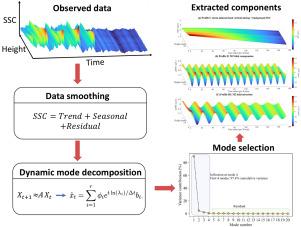从现场测量的悬浮沉积物浓度剖面中分离水平平流分量
IF 12.4
1区 环境科学与生态学
Q1 ENGINEERING, ENVIRONMENTAL
引用次数: 0
摘要
一维垂直扩散沉降(1DV)模型是泥沙动力学分析的经典工具。然而,它假设水平平流效应可以忽略不计,使得它对垂直混合强烈的沙质海岸有效,但不适用于细粒沉积物。现有的分离平流效应的方法依赖于昂贵的实验技术或基于物理过程的模型,限制了它们的实用性。为了克服这一挑战,本研究引入了一种基于动态模态分解(DMD)的数据驱动方法,使分离水平平流分量成为可能,同时降低了建模过程的复杂性。通过分层次应用DMD方法,从观测到的SSC廓线重构了3个不同分量:(1)廓线I,代表了风暴引起的垂直混合和背景浓度的综合效应;(2)剖面II,对应于与M2潮汐相关的潮汐再悬浮;(3)剖面III,代表M2潮驱动的水平平流。对各剖面的相对方差贡献率(RVCR)进行了分析,结果表明,在风暴事件期间,剖面I主导了SSC的变化,峰值贡献率为98.7%。随着风暴强度的减弱,剖面1的贡献逐渐减小,剖面2的贡献增大。风暴消散后,II型剖面成为控制细粒SSC变化的主导分量,RVCR最大值为70.9%。三号剖面的RVCR在风暴期间保持在2%以下,但在风暴过后有所增加,在整个研究期间观测到的最大值为7.8%。重建的总SSC剖面具有较高的准确度,RMSE值在0.3 g/L以下的RMSE值为83.7%,验证了该方法的有效性。该研究利用数据驱动分解方法成功地从观测的SSC剖面中分离出水平平流分量,为将1DV模型推广到粉质海岸提供了技术支持,并为泥沙输运动力学分析提供了新途径。本文章由计算机程序翻译,如有差异,请以英文原文为准。


Separating the horizontal advection component from field-measured suspended sediment concentration profiles
The one-dimensional vertical diffusion-settling (1DV) model is a classical tool for analyzing sediment dynamics. However, it assumes that horizontal advection effects are negligible, making it effective for sandy coasts with strong vertical mixing but unsuitable for fine-grained sediments. Existing methods for separating advection effects rely on costly experimental techniques or physical process-based models, limiting their practicality. To overcome this challenge, this study introduces a data-driven approach based on dynamic mode decomposition (DMD), making it possible to separate horizontal advection components while reducing the complexity of the modeling process. By applying the DMD method hierarchically, three distinct components were reconstructed from the measured SSC profiles: (1) Profile I, representing the combined effect of storm-induced vertical mixing and background concentration; (2) Profile II, corresponding to tidal resuspension associated with the M2 tide; and (3) Profile III, representing horizontal advection driven by the M2 tide. The relative variance contribution rate (RVCR) of these profiles was analyzed throughout the study period, revealing that during storm events, Profile I dominated SSC variations, with a peak contribution of 98.7%. As the storm intensity weakened, the contribution of Profile I gradually declined, while that of Profile II increased. After the storm dissipated, Profile II became the dominant component controlling fine-grained SSC variations, reaching a maximum RVCR of 70.9%. The RVCR of Profile III remained below 2% during the storm period but increased following the storm, with a maximum of 7.8% observed throughout the study period. The reconstructed total SSC profiles exhibit high accuracy, with 83.7% of RMSE values below 0.3 g/L, validating the effectiveness of the proposed method. This study successfully separates horizontal advection components from observed SSC profiles using a data-driven decomposition method, providing technical support for extending the 1DV model to silty coasts and offering a new approach for analyzing sediment transport dynamics.
求助全文
通过发布文献求助,成功后即可免费获取论文全文。
去求助
来源期刊

Water Research
环境科学-工程:环境
CiteScore
20.80
自引率
9.40%
发文量
1307
审稿时长
38 days
期刊介绍:
Water Research, along with its open access companion journal Water Research X, serves as a platform for publishing original research papers covering various aspects of the science and technology related to the anthropogenic water cycle, water quality, and its management worldwide. The audience targeted by the journal comprises biologists, chemical engineers, chemists, civil engineers, environmental engineers, limnologists, and microbiologists. The scope of the journal include:
•Treatment processes for water and wastewaters (municipal, agricultural, industrial, and on-site treatment), including resource recovery and residuals management;
•Urban hydrology including sewer systems, stormwater management, and green infrastructure;
•Drinking water treatment and distribution;
•Potable and non-potable water reuse;
•Sanitation, public health, and risk assessment;
•Anaerobic digestion, solid and hazardous waste management, including source characterization and the effects and control of leachates and gaseous emissions;
•Contaminants (chemical, microbial, anthropogenic particles such as nanoparticles or microplastics) and related water quality sensing, monitoring, fate, and assessment;
•Anthropogenic impacts on inland, tidal, coastal and urban waters, focusing on surface and ground waters, and point and non-point sources of pollution;
•Environmental restoration, linked to surface water, groundwater and groundwater remediation;
•Analysis of the interfaces between sediments and water, and between water and atmosphere, focusing specifically on anthropogenic impacts;
•Mathematical modelling, systems analysis, machine learning, and beneficial use of big data related to the anthropogenic water cycle;
•Socio-economic, policy, and regulations studies.
 求助内容:
求助内容: 应助结果提醒方式:
应助结果提醒方式:


